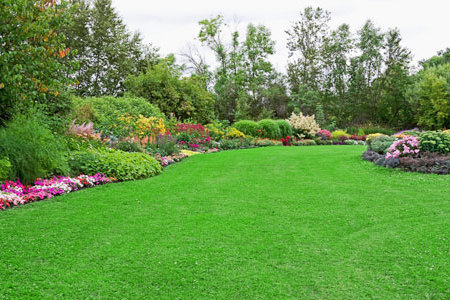
Summer is the peak growing season for your lawn, which means that it needs some extra attention during this time. Aside from mowing your lawn, you may also need to attend to your lawn’s soil fertility and weed control.
Mow your lawn once or twice a week. Mowing your lawn is one way to keep it in good health. Try to mow your lawn at least once every two weeks, but try to aim for mowing your lawn once or twice a week.
Sharpen your lawn mower blade once a year, as a sharper blade will cut your lawn without tugging at the grass.
Try to avoid cutting the grass too short, especially when the weather is very hot. During hot weather, your lawn has to put a lot of energy into regrowing grass shoots.
Fertilise your lawn once a month, after mowing. Most lawn fertilisers can be applied after mowing. Consider feeding your lawn once a month over the summer to help it stay healthy during the hot summer months.
Water the lawn using rainwater, if possible. Grass can turn brown quickly during dry periods. Watering a lawn can use up a lot of water, especially if you are using processed tap water. Instead of using the hose, try to capture rainwater in buckets and use this to water your lawn in the summer.
In addition to this practice being environmentally-friendly, lawns often prefer rainwater to tap water.
Give the lawn a good soak rather than a light sprinkle of water. If you have to water your lawn, then try to only do what is essential to keep it from turning brown and avoid running sprinklers too regularly. When watering, it is preferable to give the lawn a good soak rather than a light sprinkle so turn the sprinklers on for a full night once a week, rather than misting your lawn every night.
- Chamisa under fire over US$120K donation
- Mavhunga puts DeMbare into Chibuku quarterfinals
- Pension funds bet on Cabora Bassa oilfields
- Councils defy govt fire tender directive
Keep Reading
Too little water encourages roots to grow at the surface. This makes the lawn less drought-resistant.
Try to water your lawn during the cooler parts of the day, such as at dusk. This will allow the grass to soak up the water before the sun dries it up.
Understand that a lawn will usually recover from turning brown. While a brown lawn is less attractive, keep in mind that if your lawn does turn brown, it is very likely that it will return to its healthy green colour when cooler and wetter seasons begin.
However, if you have just laid or reseeded your lawn, it may not become green again if it is allowed to turn brown. Make an effort to water these sorts of lawns during dry spells.
Consider whether you need to reseed any bare patches. At the end of summer, consider whether your lawn has any bare patches. If it does, you will have to decide if you want to reseed your lawn in the fall.
Reseeding helps to control lawn weeds because the thick, lush grass of the lawn can crowd the weeds out.
Consider whether you need to aerate the lawn in any particular year. In particular, look at the areas that are walked on relatively often. These areas are usually found near gates or doors, or where children play. Aerating your lawn helps gases circulate and promotes better grass health. There’s some evidence that it also revitalises growth on an established lawn.
You can get special shoes with spikes on them to help aerate your lawn, or you can get a walk-behind tool with tines that poke holes in the soil.
Identify the presence of weeds. You’ll be able to spot lawn weeds if you notice flowers (especially dandelions) growing out of your lawn. You might also see the lawn has slightly inconsistent patches where the colour or texture looks different than the rest of the lawn.
Both of these appearances suggest that weeds are growing.
Keep in mind that it is easier to spot weeds if the lawn hasn’t been mowed recently.
Apply a chemical weed killer in early summer. If you decide to use a chemical weed killer, summer is the best time to apply it to your lawn as this is the main growing season for weeds.
Try to avoid applying weed killer right at the end of summer as weeds may be going dormant and it may be less effective. You may need to apply weed killer once in early summer and once later in the summer.
Choose an appropriate weed killer. When you choose a branded weed killer, consider choosing a “weed and feed” lawn treatment that both fights weeds and nourishes your lawn.
Alternately you can try targeting the individual weeds you spot. This targeted weed killer usually comes in a spray or gel form.
Use a spray bottle to target individual weeds. Using a spray bottle can make applying the weed killer more efficient. In particular, using a spray bottle works well when you are only spraying patches weeds on your lawn.
If the spray bottle nozzle is too wide, roll a piece of cardstock around the nozzle. The cardstock will create a funnel that will keep the spray from getting all over your lawn.
Refrain from mowing the lawn before applying weed killer. If using a targeted weed killer, make the job easier for yourself by applying it when the lawn hasn’t been mowed in a while. Doing this will help you to spot the problem areas, as weeds are easier to see when the lawn has been allowed to grow out a bit.
At the same time, try to avoid mowing right after you have spread your weed killer. Wait a day or two to allow the weed killer to spread through the entire weed.
Feed your lawn two weeks before applying the weed killer. Before applying your weed killer, you can consider feeding your lawn and then holding off on moving for two weeks. The lawn fertiliser will help the weeds to grow, which in turn will make it easier for you to spot them and kill them.
Don’t apply weed killer when the soil is very dry. Try to apply a weed killing chemical when the soil isn’t too dry. Consider applying the weed killer a few days after a rainfall.
Likewise, try to avoid spraying weed killer on your lawn if it is supposed to rain that day or the following day.
Refrain from feeding your lawn or applying weed killers too often. Two applications of feed or weed killing chemical per year should suffice.
Try to avoid feeding your lawn or using weed killer during the first year after you have laid your new lawn.
Try digging up the weeds as an alternative to using weed killer. To do this, you can use a variety of tools, including a hori hori blade or a weed puller. — wikihow











